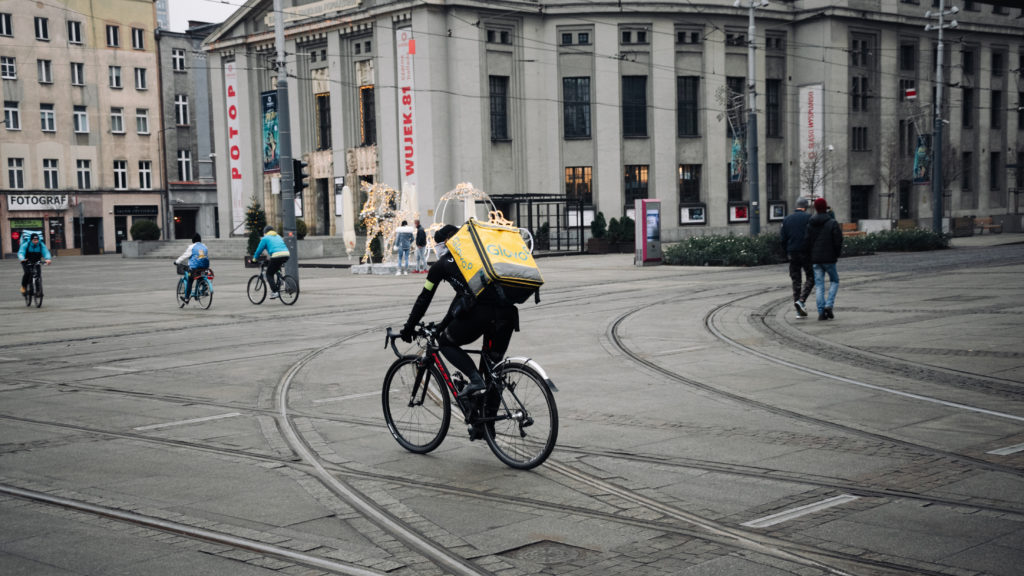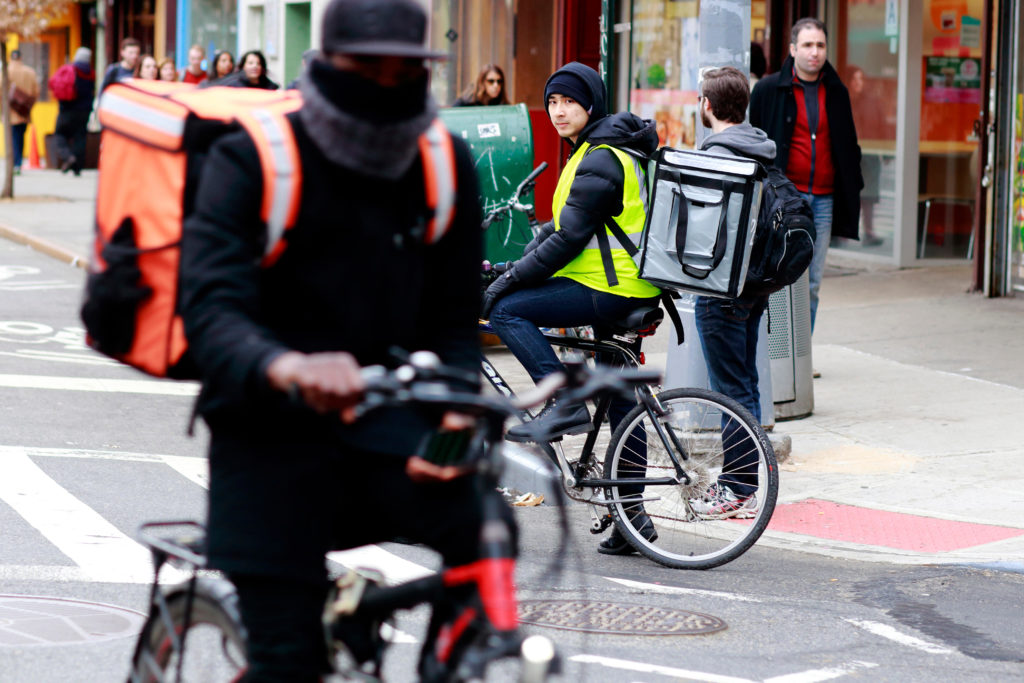The last decade saw the rise of the gig economy around the world.
More people are opting to work part-time, in temporary positions or as independent contractors, which often puts them outside the protection of labor laws.
Gig workers include two main categories: independent workers and contingent workers. The first group comprises freelancers and contractors who are self-employed and can invoice clients for services provided. Contingent workers usually work for digital platforms on an at-will basis, generally without job security or benefits such as health insurance, life insurance, sick and family leave, vacation days and retirement funds.
And yet, during the pandemic, the share of workers who say they’d choose a contract job over regular employment has risen in some parts of the world.
Proportion of workers who would choose contract work over employed roles
“The meaning of job security has been overturned,” says Nela Richardson, chief economist of the ADP Research Institute. “In April 2020, traditional jobs didn’t have the kind of security people expected when the pandemic hit.”
With widespread layoffs and furloughs, “secure” jobs weren’t necessarily a sure bet. And as people reconsidered what’s important to them, “time has been elevated in the list of worker priorities,” Richardson says. “In gig work, you have more autonomy in terms of what you take on.”
Around the world, countries are increasingly exploring ways to improve working conditions for gig workers and provide better social security. Here’s what’s happening around the world in 2022:
North and South America
According to a 2020 report by ADP Research Institute, gig workers make up 16.4% of the U.S. workforce. In about 40% of U.S. companies, one in four workers is a gig worker, and gig workers comprise more than half of the workforce in almost 20% of companies.
Raj Bhaskar, CEO of Hurdlr, a company that helps self-employed individuals track their income and tax deductions, believes there are still a lot of gray areas in how workers are classified.
“Workers in the U.S. are classified as either 1099 (independent contractors) or W-2 (traditional employees). Gig workers are treated as independent contractors, but a lot of these contractors earn very low wages with no provisions for other benefits such as health insurance or retirement pay,” he says. “The 1099 classification might need to be loosened, redefined — or maybe a third classification will be introduced — to address the gray areas and specific needs of gig workers who are yet unprotected by law.”
Although no federal laws specifically address the status of gig workers, litigation and state initiatives could lead to reclassification. In California, a judge ruled in August that Proposition 22, which allowed app-based gig platforms to continue classifying their workers as independent contractors, was unconstitutional under California law.
In Canada, a report by the Ontario Workforce Recovery Advisory Committee recommended the province develop a portable benefits plan for workers that is not tied to employers. It also suggested the creation of a job board for gig work, which would increase transparency in gig workers’ contracts, and recommended that a new category called “dependent contractor” be created for app-based gig workers. Under the plan, the workers would receive a guaranteed minimum wage and severance pay. In Latin America, lawsuits brought against digital platforms by workers and parliaments have led countries including Argentina, Brazil and Chile to weigh in on legislation to regulate the platforms’ activity.

Europe
In the United Kingdom, the number of gig workers tripled between 2016 and 2021; a study carried out by the University of Hertfordshire and BritainThinks shows that 14.7% of workers surveyed now work on gig economy platforms at least once a week, compared to 5.8% in 2016.
In February 2021, the U.K. Supreme Court ruled that Uber drivers should be classified as workers. The drivers, previously classified as self-employed, now get paid for the hours they work (rather than being paid only when they have passengers) and have other benefits such as holiday pay, rest breaks and protection against unlawful discrimination. Other countries in Europe have also taken steps to protect gig workers by changing old laws and enacting new ones for the gig economy.
In February 2021, the Milan prosecutor’s office fined four food delivery platforms a total of €733 million for violating employment safety laws and classifying riders as independent contractors. Soon after, the platform Just Eat placed riders on a national contract and gave them a minimum wage of €8.50 ($9.96) per hour, with paid leave, sick leave, social security and insurance, as well as union representation. In December, prosecutors announced they had reached a deal with the other platforms.
In Portugal, the government approved a bill in October requiring gig platforms such as ride hailing and food delivery companies to grant employee status to their riders and drivers. The bill is currently undergoing parliamentary review.
Some of the new laws have not been well received by gig workers. In Spain, a new “rider law” came into force in August 2021 to give delivery riders full employment rights. Companies’ reactions have varied. Deliveroo decided to pull out of Spain entirely, while other companies changed their algorithms to give riders flexibility but fewer assignments, which means less money for them. Some of the workers said they were worse off with the new law.
In December 2021, the European Commission proposed new rules for digital platforms that would reclassify up to 4.1 million gig workers as employees.
The meaning of job security has been overturned.
Nela Richardson, ADP Research Institute
Australia
In Australia, the gig economy grew nine-fold between 2015 and 2019, to a total worth of about $6.3 billion, with a gain of 32% in 2019 alone. When the pandemic hit and underemployment rose to a record high of 13.8%, more people joined the gig economy to work.
In the First Interim Report presented to the Australian Parliament in June 2021, a Senate committee raised concerns about a lack of basic job protections and low pay for gig workers. The report said that workers should be “paid at a rate that rightly recognizes the value of the work that they do, that they are provided with other conditions that ensure they do not have to work when they are sick, they are safe at work and their families are not left destitute when they are injured or killed, that they are paid superannuation to underpin a financially stable future, and that they can access other labor protections providing dispute resolution and mechanisms for addressing discrimination and harassment.”
Asia
China has more than 7 million delivery riders who face stressful working conditions, according to studies by Beijing Yilian, a research institute that focuses on labor laws. More than 95% work for more than eight hours a day — and about 39% work up to 12 hours daily — to meet demands set by the food delivery platform algorithms.
China’s Administration for Market Regulation issued new rules in July 2021 to improve riders’ work conditions. Food delivery companies are now required to guarantee a base income and social welfare for their riders. The law also specifies lighter assignment loads, as well as more relaxed performance evaluations and delivery deadlines. The workers must also be able to join unions.
In Malaysia, more than 145,000 delivery riders became eligible for benefits under the Social Security Organization’s SPS Lindung scheme for self-employed people. These workers are now eligible for medical benefits, education and rehabilitation benefits.
Countries such as the Philippines and Singapore are also considering added security for gig workers. In a speech in August, Singapore’s Prime Minister Lee Hsien Loong praised gig workers, whose services were critical during the pandemic. He said that the Ministry of Manpower was studying how to create better working conditions for gig workers.

Africa
In Africa, in the absence of laws focused on gig workers, those workers have been banding together to push for change. A Kenyan court ruled in October 2021 that drivers could sue Uber Kenya over alleged contract violations after years of confusion resulting from conflicting domain names and corporate veils.
In South Africa, labor NGOs have encouraged the public to patronize gig platforms that provide some form of security for their workers, especially during lockdowns. A study carried out by the Fairwork Foundation rated the platforms in five areas — pay, working conditions, contracts, management and representation — and highlighted platforms that provided financial support, training and safety gear.
Challenges of regulation
The International Labor Organization said in a 2021 flagship report that there needs to be international policy dialogue and coordination since digital labor platforms operate across multiple jurisdictions.
In a paper published by the ILO, Cristina Banks of the University of California at Berkeley wrote that gig work will dominate global economies in the future, making it important to address the health and economic risks of gig work now.
“An interdisciplinary approach could determine how gig workers’ basic needs could be met through changes in work design and the development of worker support systems,” Banks wrote.
By taking steps such as adopting employer-funded compensation for gig workers, implementing community policy and planning, providing legal protections for gig workers, and building better apps, “gig work could be a viable economic and fulfilling career path,” she wrote.
Hurdlr’s Bhaskar believes that in the future, security for gig workers will be achieved through innovations in the private sector — not just by government intervention.
Platforms will realize that making big profits with impoverished workers will no longer work.
Raj Bhaskar, CEO of Hurdlr
“Just like companies began to raise starting wages after the pandemic without government intervention, in the near future, market forces will play out in such a way that platforms will realize that making big profits with impoverished workers will no longer work,” he says.
ADPRI’s Richardson says the current debate on the gig economy can be traced back to 2008. In the aftermath of the financial crisis, firms increasingly relied on contingent workers — but didn’t provide benefits that kept pace with the rise in demand.
“Perhaps we need to acknowledge this growing demand in an uncertain economy,” she says. “To keep the workforce engaged and ready, you have to compensate them in some way, like with more benefits and job security.”
Richardson also believes the gig economy is still gaining momentum. “Given the global labor shortages, this is probably just the beginning of the issue,” she says. “Like all workers, gig workers are understanding that they have a bit more bargaining power than they did before.”
Read more
Sign up to keep up to date with ReThink Q.







